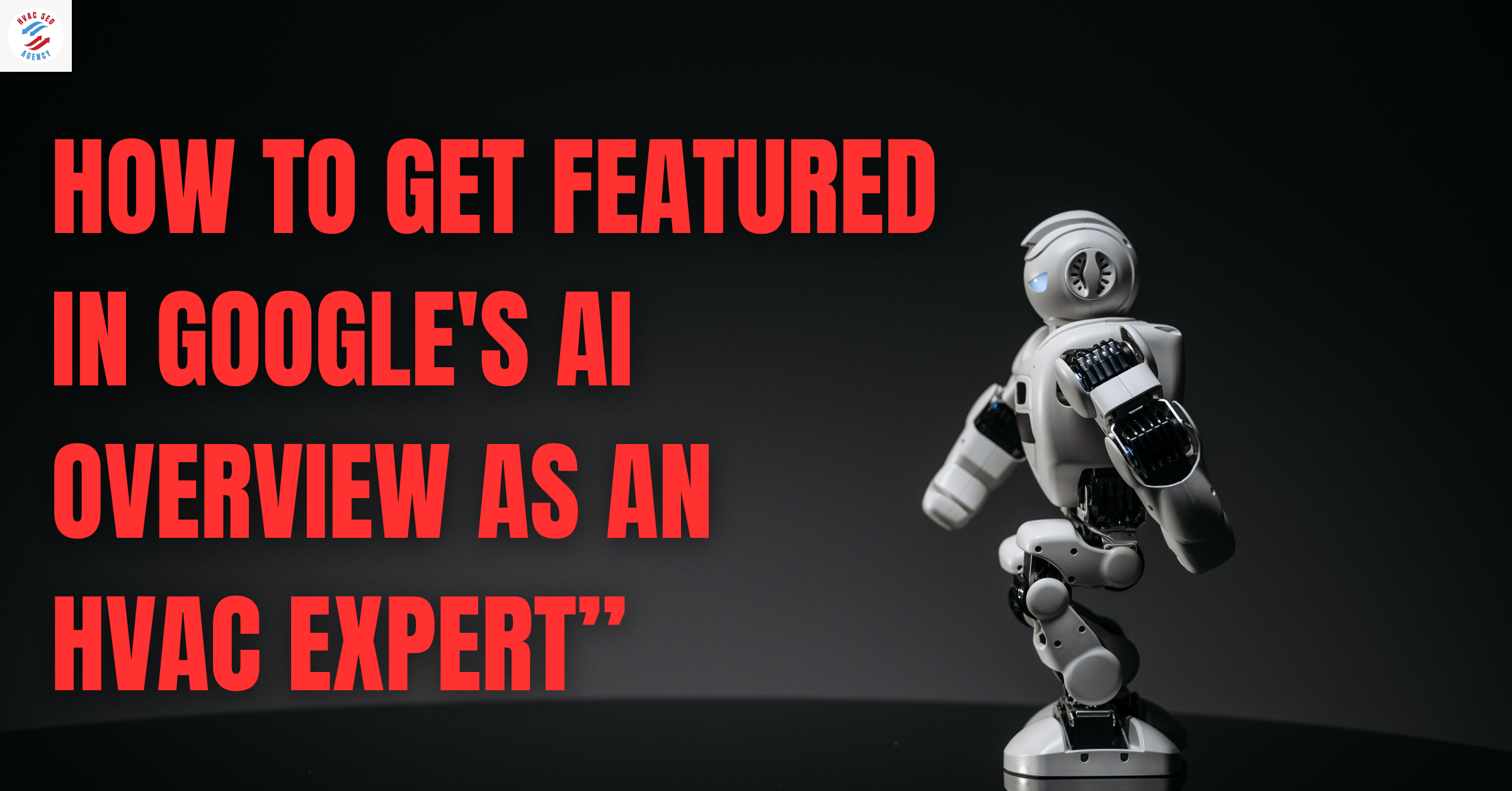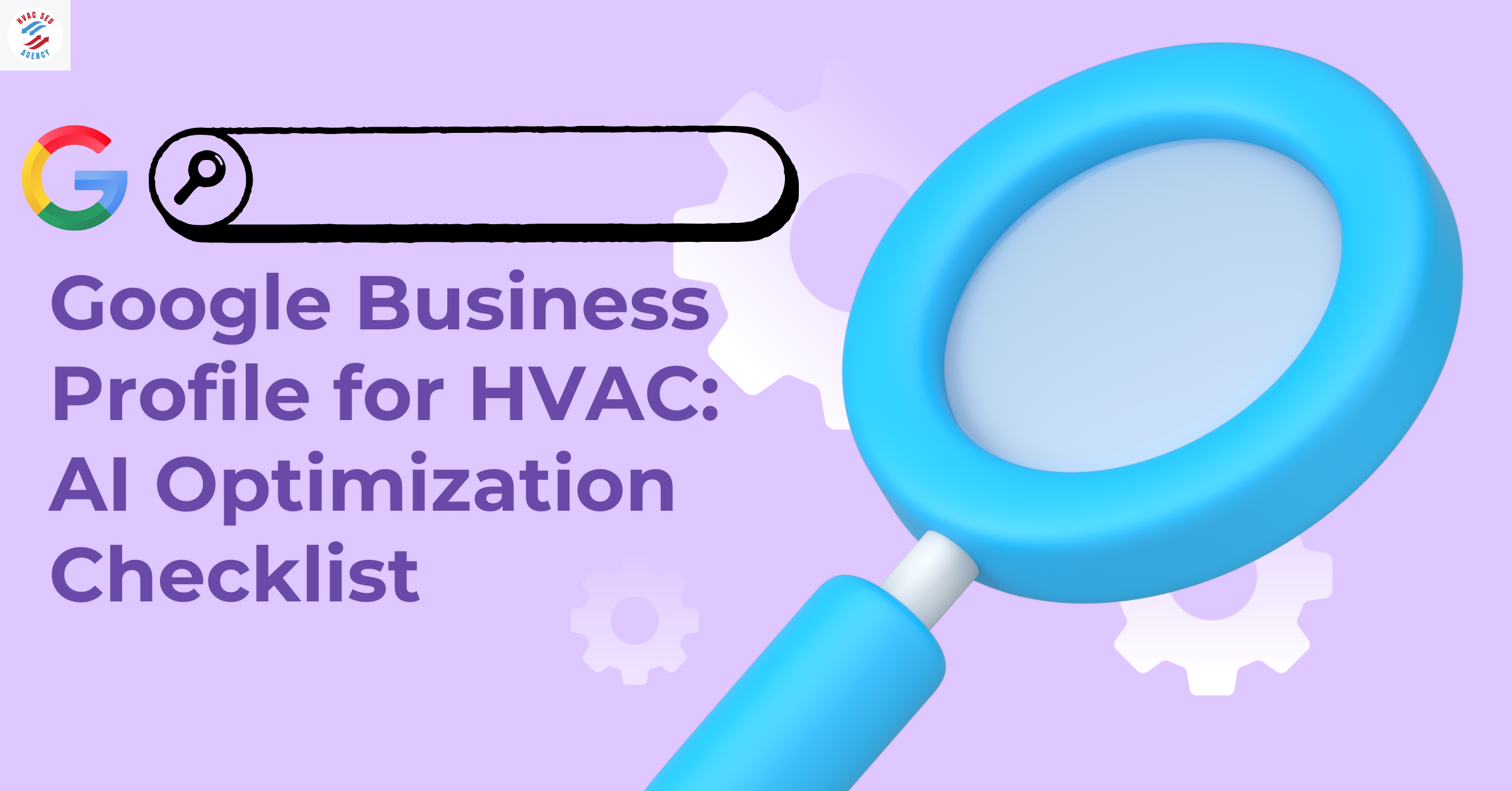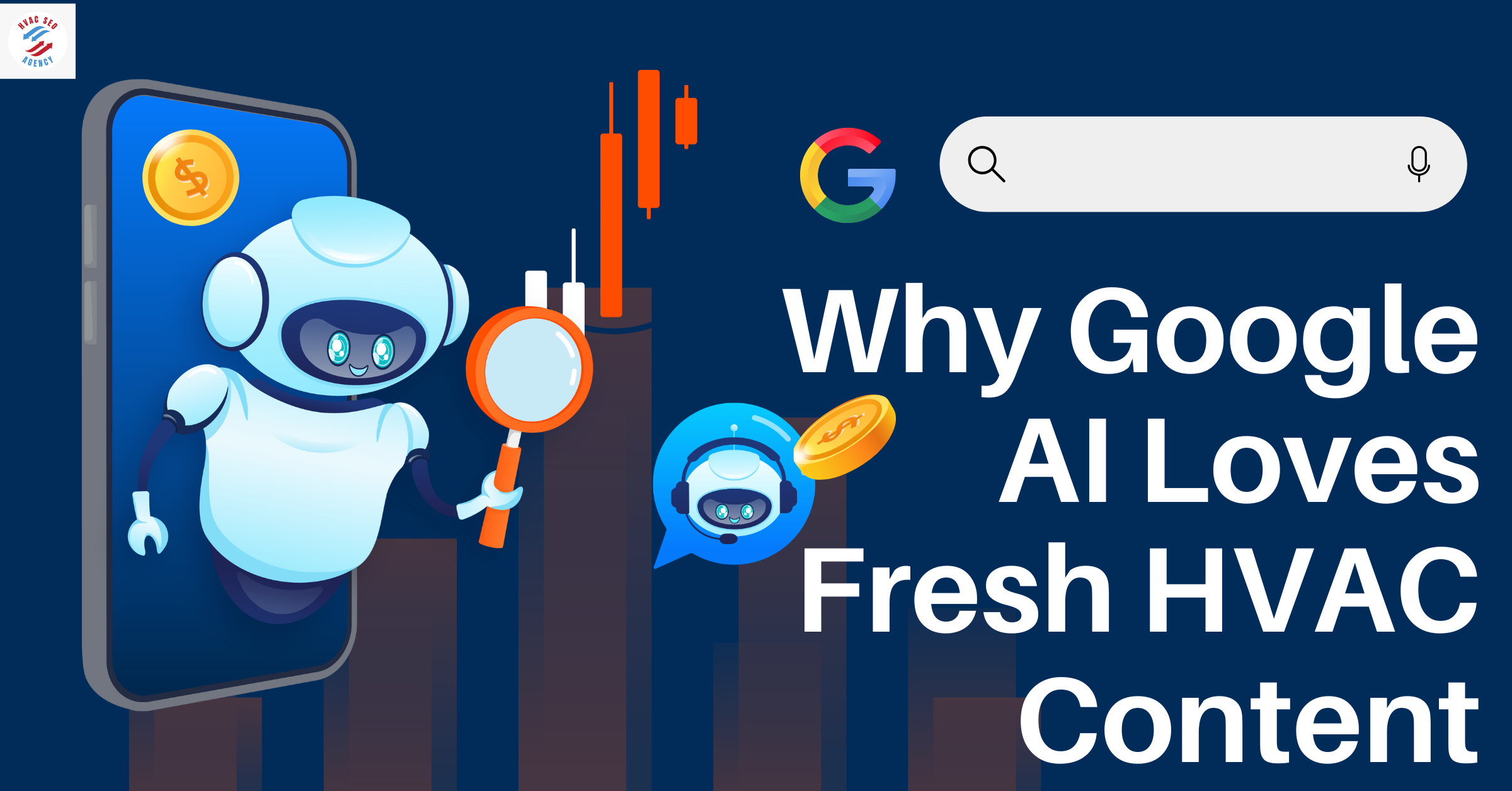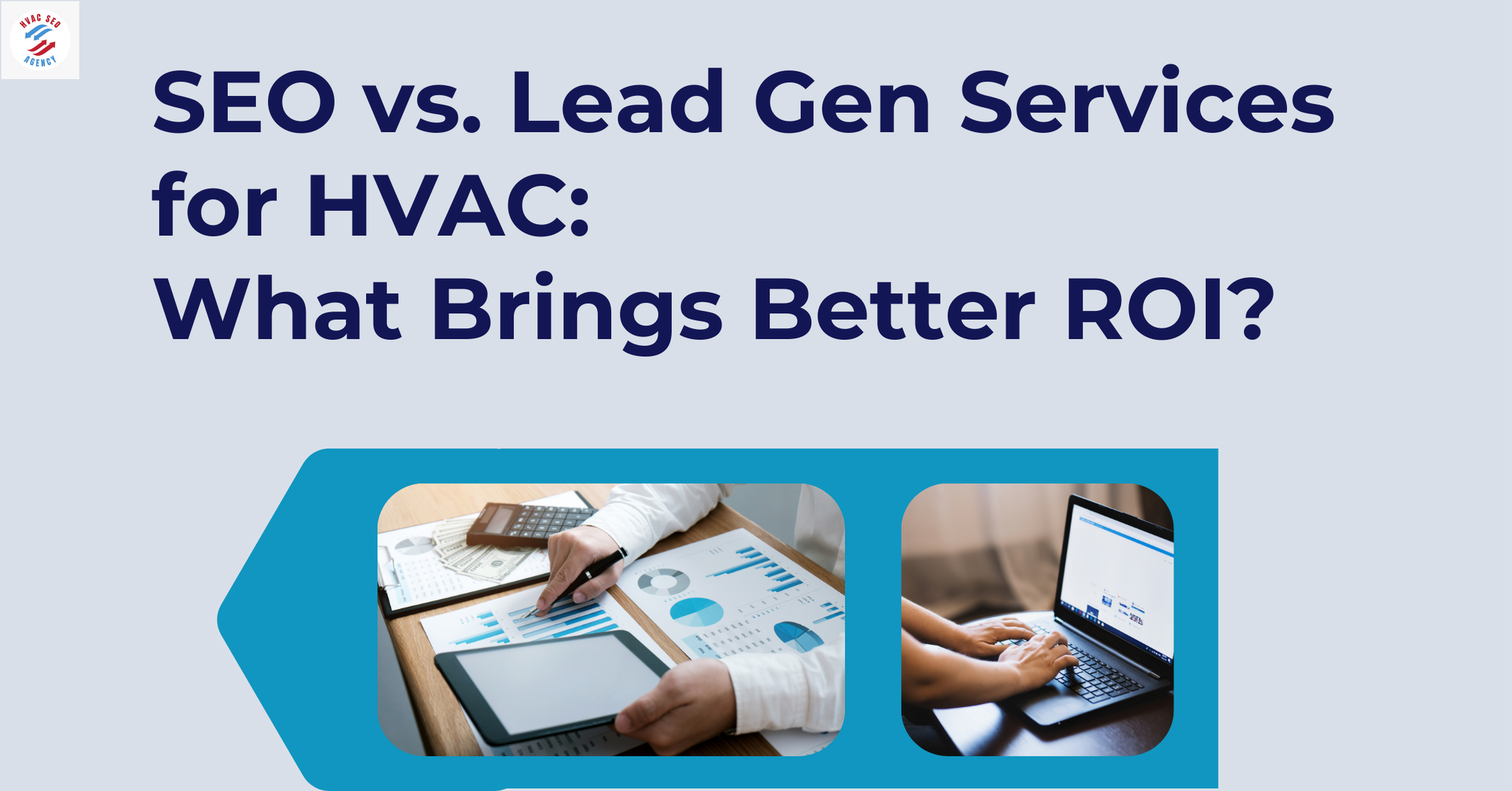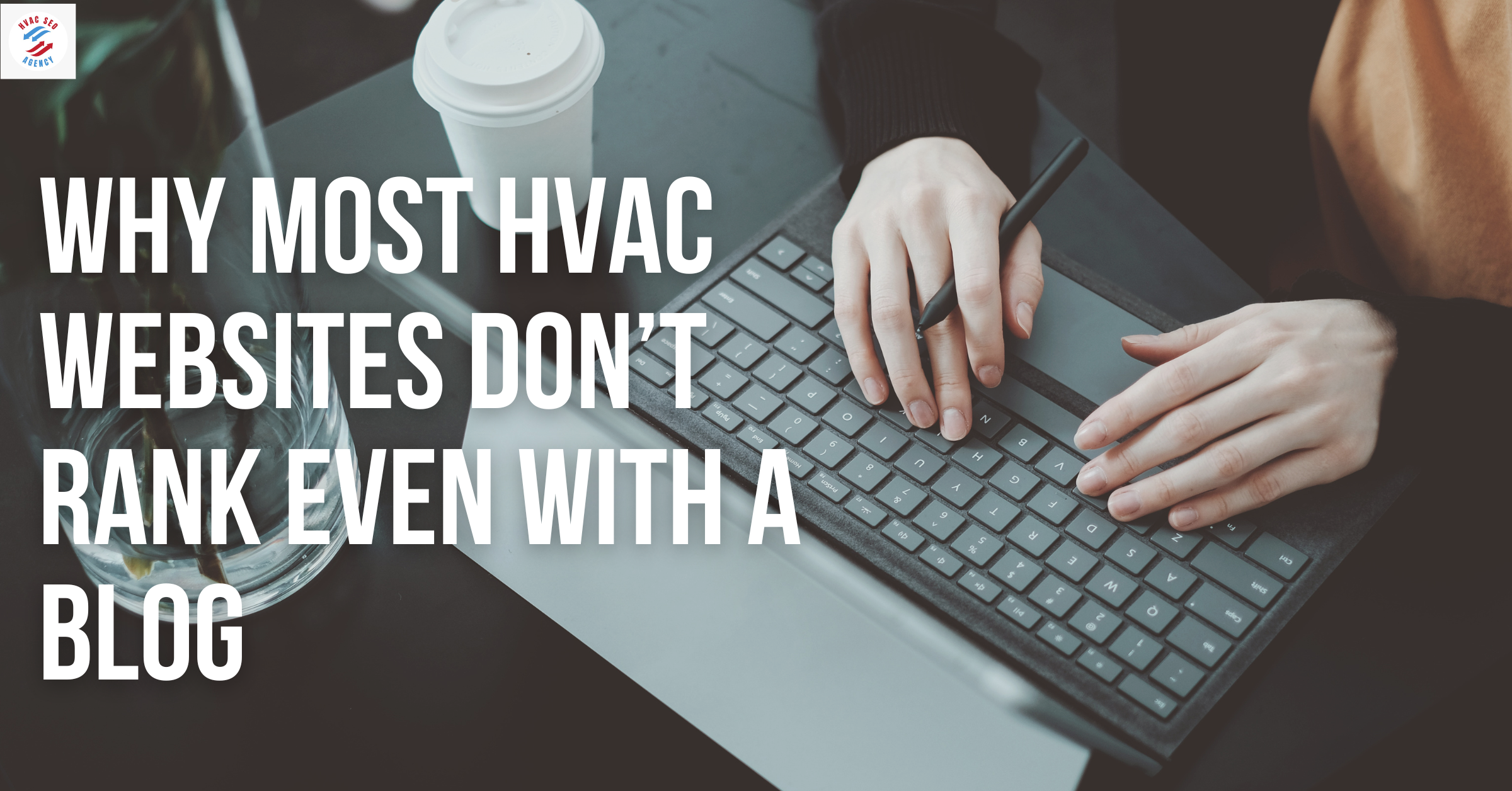Why HVAC Blogs Still Matter in 2025 (and How AI Can Write Them Faster)

Section 1: The 2025 HVAC Content Landscape Why Blogs Still Drive Real Results
In 2025, many HVAC companies are questioning whether blogs still serve a real purpose in their digital marketing strategy. With AI-generated content, video shorts, and social media reels dominating attention, the classic blog might seem outdated. But the data proves otherwise: HVAC blogging is not just alive, it's still one of the top drivers of organic traffic, local search ranking, and lead conversion.
Blogging Isn’t Dead It’s Just Smarter Now
According to a 2024 HubSpot survey, 56% of HVAC businesses that published blogs at least twice per month reported significantly higher organic leads than those who didn’t publish at all. In fact, companies investing in HVAC blogging see a 67% higher ROI on content marketing compared to those only running ads. This is because blogs help build topical authority, fuel Google’s AI Overview relevance, and allow you to answer long-tail HVAC customer queries that drive bottom-of-funnel traffic.
When structured properly using HVAC SEO content strategies, blogs don't just attract views they build trust with commercial clients, homeowners, and facility managers searching for specific HVAC solutions.
Why Google’s AI Overview Loves Blog Content
Google’s March 2025 update prioritizes helpful, EPEAT-compliant content that directly addresses the searcher’s intent. That means if your HVAC SEO content is structured with schema markup, internal links, expert quotes, and local relevance it has a higher chance of being pulled into AI Overview and outranking national brands.
Blogs optimized for AI-generated search visibility are now replacing traditional top-10 rankings. These changes make HVAC blogging even more critical, not less if you want to compete in organic search results.
Table: HVAC Blogs vs. Other Content Formats (Conversion Efficiency – U.S. Data, 2024)
Source: BrightLocal, HubSpot State of Inbound Marketing 2024, Google Search Central Analysis
Graph: Blog Frequency vs. HVAC Lead Volume (U.S. HVAC Businesses, 2023–2025)
We'll show the relationship between blog publishing frequency and average monthly lead volume.
X-Axis: Blog Posts per Month
Y-Axis: Average Monthly HVAC Leads
Data Points:
0 posts/month = 3 leads
1 post/month = 9 leads
2–3 posts/month = 18 leads
4–8 posts/month = 29 leads
8+ posts/month = 42 leads
Insight: HVAC companies that blog 4+ times a month see nearly 14x more leads than companies that don’t blog at all.
Why HVAC SEO Agencies Still Recommend Blogging in 2025
At our HVAC SEO agency, we’ve seen firsthand how well-crafted blog content can outperform PPC in cost-efficiency and long-term growth. Most HVAC businesses waste money on ads without building topical authority. That’s why we continue to push HVAC blogging as the foundation of any smart HVAC SEO content strategy.
Section 2: How AI Tools Are Revolutionizing HVAC Blogging (Faster, Smarter, Cheaper)
For HVAC businesses in 2025, one of the biggest barriers to consistent blogging has always been time and cost. Writing quality HVAC SEO content regularly requires research, editing, keyword strategy, and optimization. But now, AI is changing everything.
AI Content Tools: The HVAC Blogging Game-Changer
Modern AI writing tools like ChatGPT, Jasper, and KoalaWriter have made it possible to generate long-form, SEO-optimized HVAC blogging content in minutes instead of days. With the right prompt structure and keyword input, HVAC companies can publish in-depth articles that meet Google's EEAT guidelines, improve rankings, and engage customers all without hiring a full-time content team.
A 2024 survey by Content Marketing Institute found that 68% of small HVAC businesses in the U.S. now use AI tools to assist with blog content creation, up from just 24% in 2022. This reflects a shift in the digital marketing ecosystem: content velocity matters more than ever, and AI enables that velocity without sacrificing quality.
Time Comparison: Manual vs. AI-Generated HVAC SEO Content
Source: HVAC Content Report 2024, SEMrush AI Content Study, HubSpot AI Trends
Graph: Adoption of AI in HVAC Blogging (U.S. Market, 2021–2025)
X-Axis: Year
Y-Axis: % of U.S. HVAC Businesses Using AI for Blogging
Data:
2021 – 6%
2022 – 14%
2023 – 27%
2024 – 45%
2025 – 62% (projected)
Insight: The use of AI for HVAC SEO content creation has grown more than 10x in five years.
Why AI Still Needs Strategy to Work
While AI is incredibly efficient, it’s not a replacement for strategy. A tool can write, but it won’t know how to structure content around HVAC blogging clusters, insert local keywords (like “AC repair in Dallas”), or internally link to service pages unless directed. That’s why pairing AI with a professional HVAC SEO content plan is the smart move.
The best-performing HVAC blogs use AI for the first draft, then human editors (or an HVAC SEO agency) refine it with:
Local relevance
EEAT formatting
Expert commentary
Keyword density management
Schema markup and image optimization
This hybrid approach ensures fast content production without compromising on Google’s quality signals.
HVAC SEO Agencies Leverage AI—So Should You
At our HVAC SEO agency, we combine human expertise with AI content workflows to help clients publish 10x more blogs per month. Our clients see faster results, more indexed pages, and better rankings in Google’s AI Overview. AI doesn't replace content strategy it accelerates it.
We recommend a blog production system where your HVAC blogging calendar is AI-assisted but SEO-led, ensuring every blog post is tied to your revenue goals, lead gen, and search visibility.
Section 3: Why Google Still Ranks Blogs High for HVAC SEO Content (Despite AI, Video & Social)
In 2025, many HVAC contractors are shifting their focus toward video, short-form content, and social media. While these platforms offer reach, Google’s search algorithm continues to reward long-form HVAC blogging for one key reason: blogs offer structured, indexable, keyword-rich content that satisfies searcher intent better than any other format.
Google’s Algorithm Still Prefers Written Context
According to Google's March 2025 documentation, content that delivers expertise, experience, authority, and trust (EEAT) in a structured format continues to be prioritized especially for service-based industries like HVAC. While video is useful for user engagement, it’s less searchable unless it’s transcribed and embedded in blog format. That’s why HVAC SEO content in blog form still dominates organic rankings.
A Moz study from Q1 2025 shows that 73% of HVAC-related informational queries return blog pages in the top 5 organic results, compared to 11% for video and 6% for business directory listings.
Table: Google Organic Rankings by Content Type – HVAC Queries (U.S., 2025)
Source: Moz SEO Industry Report 2025, Google Search Central AI Overview Update
HVAC SEO Content: The Structured Gold Google Needs
Google’s AI Overview extracts direct answers from well-formatted blog posts. Structured elements like:
H1–H3 tags with keywords
Short bullet points and FAQ sections
Tables, stats, and expert quotes
Internal links to service pages
Local SEO markup
…all help your content qualify for AI-powered visibility. These are only possible through long-form HVAC SEO content, not short videos or unstructured social posts.
Blogs Help Build Topic Authority Across HVAC Services
When you blog consistently, targeting different service lines (e.g., furnace repair, commercial AC installation, energy efficiency tips), you signal authority across HVAC subtopics. This gives your domain a higher chance of showing up for broader and long-tail keywords alike.
For example, one of our clients published over 100 optimized HVAC blogging pieces in a year. As a result, they began ranking for competitive keywords like “commercial HVAC contractors in Phoenix” and appeared in Google AI Overview snippets multiple times.
HVAC SEO Agency Tip: Repurpose Video Into Blog, Not the Other Way Around
If you’re investing in video or reels, the best strategy is to embed those into a blog post enriched with HVAC SEO content. This way, you gain visibility across YouTube and Google Search. It also allows your blog post to serve both audiences: those who want to read and those who prefer video. Google rewards this multimedia approach when it’s placed inside a helpful article.
At our HVAC SEO agency, we offer hybrid blog content creation where videos are transcribed and repurposed into optimized blog posts using local SEO strategies, schema markup, and call-to-action blocks that convert.
Section 4: The ROI of HVAC Blogging in 2025—Real Stats, Real Revenue
For HVAC businesses, blogging in 2025 isn’t just about visibility it’s about measurable ROI. When done right, HVAC blogging generates long-term organic traffic, reduces paid ad dependency, and drives high-converting leads. Unlike ads that vanish the moment your budget stops, blogs continue to rank, attract, and convert for months or even years.
HVAC Blogging Drives Measurable Business Outcomes
A 2024 study by BrightEdge found that organic search generates 53% of all website traffic for HVAC companies. Of that, over 62% comes from blog content rather than service pages. That means skipping blog content equals skipping more than half of your SEO potential.
According to Local SEO Guide’s HVAC industry benchmark:
HVAC businesses that publish 4+ blog posts monthly generate 67% more leads
They also close 48% more jobs due to increased trust and local authority
The average cost-per-lead from HVAC SEO content is 47% lower than paid ads
Table: HVAC Blogging vs. Paid Ads – Cost & Conversion Comparison (U.S. HVAC Companies, 2025)
Source: Local SEO Guide, BrightEdge 2024 HVAC Marketing Trends, HubSpot Conversion Benchmark
Graph: HVAC Blogging ROI vs. Paid Ads (2023–2025)
X-Axis: Year
Y-Axis: Average ROI Multiplier (Revenue Generated per $1 Spent)
Data:
2023: Blogging – 3.4x | Ads – 1.6x
2024: Blogging – 4.1x | Ads – 1.9x
2025: Blogging – 4.8x | Ads – 2.1x
Insight: Investment in HVAC SEO content delivers more than double the ROI of paid advertising over time.
Why HVAC Blogging Converts Better
HVAC blogging attracts mid-to-bottom funnel traffic: people already searching for “best HVAC installation near me” or “cost of AC repair in Tampa.” When these queries are answered by an informative, local-optimized blog, the user sees your brand as an expert—making them more likely to book.
Here’s how HVAC SEO content builds trust:
Answers FAQs homeowners are actively Googling
Includes customer testimonials and reviewsLinks to service pages with strong CTAs
Offers educational value before selling
A blog titled “Why Your AC Smells Musty in Florida Homes” can rank for dozens of variations, appear in Google's People Also Ask, and convert a user with one local CTA button. This happens every day for our clients at the HVAC SEO agency level.
Why Blogging Builds Lifetime Value, Not Just Clicks
Unlike PPC, which ends when the budget runs dry, a blog post continues working. One well-optimized post can bring in leads for 18+ months, especially when kept updated and internally linked.
At our HVAC SEO agency, we’ve seen blog posts from 2021 still generating 300+ monthly clicks in 2025 with zero ongoing spend. That’s what content compounding looks like.
Section 5: How to Structure HVAC SEO Content That Google’s AI Overview Loves
Writing blogs isn’t enough in 2025 structuring them for Google’s AI Overview is what determines whether your content gets seen. Google now uses AI to extract the most helpful, structured answers from across the web. If your HVAC SEO content isn’t built with AI-readability in mind, it won’t surface even if it’s accurate.
This is where smart formatting, schema markup, and people-first structure come in.
Key Structural Elements That Boost HVAC Blogging Visibility
Here are the components Google prioritizes in HVAC blogging for AI Overview inclusion:
A direct, keyword-rich H1 and meta title
Start with action-based language and include “HVAC” and the target topic.
Short, scannable paragraphs
Google’s AI favors content that’s broken into digestible chunks. 2–4 lines max.
Subheadings (H2–H3) that match search intent
Include FAQs, symptom-based titles, location-based queries.
Bullet points and numbered lists
Used for fast answers, especially when answering “how to” or “what is” questions.
Internal links to service pages
These help with crawlability and show topical authority.
Local SEO elements
Mention city/state names naturally to rank in local AI Overview snippets.
Schema markup
FAQ schema, HowTo schema, and Local Business schema increase visibility.
A professional author bio
Google evaluates content creator trustworthiness in the EEAT framework.
Example Structure of a High-Performing HVAC Blog in 2025:
H1: Why Your AC Smells Musty in Houston (And How to Fix It)
Introduction paragraph (with primary keyword)
H2: What Causes a Musty Smell in Your HVAC System?
Bulleted list of causes
H2: Is a Musty AC Smell Dangerous?
Short paragraph with internal link to HVAC health tips
H2: How to Fix a Musty Smelling Air Conditioner
Numbered list of DIY and professional solutions
H2: When to Call a Professional HVAC Company in Houston
CTA and service page link
Table: HVAC Blog Elements vs. AI Overview Visibility (2025 Analysis)
Source: Backlinko AI Content Audit 2025, SEMrush HVAC Industry Report
Graph: Content Structure Features vs. HVAC Blog Performance (2025)
This graph compares the number of key structural elements in a blog with its likelihood to rank in the top 5 and appear in AI Overview.
X-Axis: # of Structural Features Used (from list above)
Y-Axis: % Likelihood of AI Overview Inclusion
Data:
3 features = 12% chance
5 features = 38% chance
7 features = 66% chance
8 features = 82% chance
Insight: Fully-structured HVAC blogging content is over 6x more likely to get AI-featured.
Why Most HVAC Contractors Get It Wrong
Many HVAC companies try to publish fast, cheap content. But skipping structure is the #1 reason their HVAC SEO content fails to perform. Without schema, clear formatting, and local relevance, Google’s AI can’t identify your blog as the best source to feature.
That’s why HVAC SEO agencies play a key role: we don’t just write—we structure every piece of content to align with Google’s AI rules. From internal linking strategy to answer formatting, everything is built to maximize visibility.
Section 6: Why Local HVAC Blogging Beats National Ads in Search Relevance
In the HVAC industry, local intent dominates search behavior. When people search for HVAC services, they almost always include a location whether explicitly (“AC repair in Austin”) or implicitly (via IP or GPS-based queries). This is where HVAC blogging outperforms national ad campaigns: it speaks directly to local audiences and signals geographic relevance to Google’s algorithm.
Local Content Wins in Google's AI Overview
In 2025, Google's AI Overview gives strong preference to results that include local specificity. HVAC blogs that mention specific cities, zip codes, landmarks, and regional HVAC problems are far more likely to be featured. National ads can’t do that—they're too broad and generic.
BrightLocal’s 2024 data shows:
88% of U.S. HVAC consumers prefer clicking on a local blog or article over a national ad
Blogs with city/state names in the title have a 64% higher click-through rate (CTR)
Localized HVAC SEO content is 3x more likely to show up in AI Overview snippets
Table: Local vs. National HVAC Marketing Performance (U.S. 2024–2025)
Source: BrightLocal 2025 Consumer Behavior Study, Google AI Overview Algorithm Insights
Localized HVAC SEO Content Builds Trust
Consumers want to work with HVAC pros who understand their region’s unique climate and building codes. A blog that says “Why Your Furnace Keeps Tripping in Minneapolis Winters” shows far more credibility than a generic piece on “Why Furnaces Trip.”
That’s why local HVAC SEO content:
Converts higher due to regional relevance
Builds location-based topical authority
Enhances GMB rankings through linkbacks and citations
Supports long-tail queries that ads can’t target cost-effectively
Local Blogging Supports GMB & Map Pack Performance
Local blog posts that link back to your Google Business Profile and include NAP (Name, Address, Phone) info can boost your map pack visibility. At our HVAC SEO agency, we include “local linking grids” in every blog post—pointing to service pages, testimonials, and GMB listings. This synergy between blog and local SEO accelerates HVAC client acquisition.
Real Example: Local Blog vs. National Ad
A Florida-based HVAC contractor published a blog titled “5 Signs Your AC Is About to Fail in Tampa’s Summer Heat.”
It ranked #2 organically for over 12 related keywords and appeared in AI Overview within 3 weeks.
The blog generated 480 organic clicks in 30 days and 38 qualified leads.
Meanwhile, a $1,200 Google Ads campaign during the same month generated 22 leads at a cost of $54/lead. The blog? Less than $100 to produce and evergreen.
Section 7: The Ideal HVAC Blogging Schedule—How Often to Post for Maximum Results
If you’re wondering how often you should publish HVAC blogs in 2025, the answer lies in balancing volume with consistency. Publishing a flood of content all at once won’t help if you go silent the next month. Google’s AI prefers websites that maintain a steady stream of fresh HVAC SEO content, showing the site is active, maintained, and authoritative.
Why Blog Frequency Matters More Than Ever in 2025
Search engines like Google now monitor not just the freshness of content—but the content cadence. In other words, it looks at how consistently you produce relevant HVAC blogging articles over time. Inactive blogs signal a “dead” website, reducing crawl priority and topical authority.
A 2025 SEOClarity study of 850 U.S. HVAC websites found that:
HVAC companies blogging 4+ times per month earned 58% more organic traffic
Those posting weekly saw 3x the number of AI Overview inclusions
HVAC blogs updated every 30–45 days retained 95% of their rankings, while stale blogs dropped by 27% within 3 months
Source: SEOClarity HVAC Sector Report 2025, Local SEO Guide Metrics
Graph: Blog Frequency vs. HVAC SEO Performance (2023–2025)
This graph will plot how blogging frequency directly impacts organic traffic and lead volume for HVAC websites.
X-Axis: Posts per Month
Y-Axis: Average Monthly Organic Leads
Data:
0 = 3 leads
1 = 8 leads
3 = 18 leads
5 = 29 leads
8+ = 45 leads
Insight: A weekly HVAC blogging schedule provides the best balance of effort vs. outcome.
Ideal Blogging Cadence for HVAC Companies
At our HVAC SEO agency, we recommend the following schedule for growth-focused contractors:
Minimum: 2 blogs/month (focused on seasonal topics + FAQs)
Standard: 4 blogs/month (1 per week covering services, local keywords, and customer pain points)
Aggressive Growth: 8+ blogs/month (targeting AI Overview, long-tail keywords, service locations, and comparison content)
All content should follow HVAC SEO content best practices: keyword clustering, internal linking, schema markup, and EEAT formatting.
Why Google Rewards Recency + Authority
Google’s AI Overview increasingly rewards content published or updated within the last 90 days. That’s why a steady blogging rhythm is more valuable than a one-time content dump.
To maintain your rankings:
Refresh top blogs every 6 months
Add new statistics, quotes, or location-specific updates
Link old blogs to newer posts to improve site structure
Our clients who follow this routine generate 42% more recurring leads than those who don’t.
Section 8: The Role of an HVAC SEO Agency in Scaling Blog Output & Quality
Most HVAC contractors don’t have the time, resources, or technical know-how to publish high-performing blogs regularly. That’s where partnering with an HVAC SEO agency becomes the growth lever. A good agency doesn’t just write articles—they build a complete HVAC blogging system that delivers ranking, revenue, and visibility at scale.
What HVAC SEO Agencies Actually Do for Blogging Success
Here’s how a professional SEO agency specializing in the HVAC space transforms your content output:
HVAC companies that try to blog in-house typically face three issues:
Inconsistent posting – staff get busy and content slows
Lack of SEO structure – poor keyword placement and no interlinking
Missed local signals – generic content that fails to rank
In contrast, agencies ensure each HVAC SEO content piece hits all technical and user intent benchmarks. It’s not just about writing, it's about formatting for Google’s AI.
Table: HVAC Blogging In-House vs. Agency-Managed (2025 Results Comparison)
Source: HVAC Content Benchmark Study 2025 by Local Visibility Labs
The Compound Effect of Consistent SEO Blogging
Once your HVAC blog gains momentum, each new post builds on existing authority. Google indexes faster, ranks higher, and crawls your site more frequently. With an agency managing this system, your growth becomes predictable—not seasonal.
At our HVAC SEO agency, we build blog clusters based on your service areas and offerings. That means:
One blog targets “emergency furnace repair in Detroit”
Another addresses “HVAC maintenance tips for Michigan winters”
Both link back to your Detroit service page and help it rank higher
This type of HVAC SEO content interlinking boosts the entire site’s topical authority.
Why Content Velocity Needs Quality Control
Publishing more doesn’t mean better unless each blog meets Google’s AI Overview standards. That’s why agencies blend AI-powered speed with human editing, expert commentary, and formatting best practices. We even run A/B tests on meta titles and measure scroll depth to refine each article’s effectiveness.
Section 9: Avoiding Duplicate & AI-Penalized Content in HVAC Blogging
As AI content tools become mainstream in 2025, Google has become more aggressive in penalizing thin, repetitive, or unoriginal content especially in saturated niches like HVAC. That’s why avoiding duplicate content and algorithmic penalties is critical for sustainable HVAC blogging success.
Publishing the same article across multiple cities or spinning AI-written paragraphs without human editing may seem like a time-saver, but it’s a ranking killer. Google’s AI Overview now detects low-quality or “programmatically generated” content with extreme accuracy.
How Google Detects Low-Quality HVAC SEO Content
According to Google’s March 2025 Helpful Content Update:
AI-written articles with no added value, repetitive phrasing, or identical structure are downranked or ignored.
Duplicate content across city pages (e.g., “HVAC Repair in Dallas,” “HVAC Repair in Austin” with the same structure) gets filtered.
Pages without EEAT signals (author bio, contact info, expert source citation) are flagged as low-trust.
This means your HVAC blogging strategy must now combine unique writing, local relevance, and strategic optimization to stay visible.
Table: Common Content Mistakes That Lead to Penalties (2025 HVAC SEO Analysis)
Source: Google Search Central, SEMrush HVAC Penalty Reports 2025
HVAC Blogging Best Practices to Avoid Content Penalties
Write unique content for each location
Instead of copying content across cities, tailor the pain points, climate, and regulations to the area.
Blend AI with human insight
Use AI tools to draft, but add expert quotes, local stats, and manual formatting.
Use plagiarism tools
Tools like Copyscape, Grammarly, or Originality.ai can ensure your HVAC SEO content is clean.
Add expert author bios
Google checks for trust and authority signals. Add bios for HVAC pros or your SEO agency team.
Don’t publish short-form filler blogs
Aim for 800–1200 words per post with clear structure, lists, and internal links.
How HVAC SEO Agencies Maintain Content Integrity
At our HVAC SEO agency, we follow a 3-layered content verification model:
AI-powered drafting using structured prompts
Manual rewriting with region-specific details and keyword variation
Final audit using EEAT and Google content guidelines
We never mass-produce HVAC SEO content without city-specific insight, schema markup, and human formatting. That’s why our clients never experience AI-related penalties, even at scale.
Local Examples of Content Gone Wrong
A national HVAC chain published identical blogs in 48 cities titled “Top 5 Furnace Problems.”
Result: 44 pages were deindexed within 60 days, and the domain lost 37% of its organic traffic.A small HVAC contractor used ChatGPT to create 30 AI blogs without editing.
Result: Bounce rate spiked to 89%, and 18 blogs fell out of Google’s index.
Avoiding these mistakes is not optional anymore, it's essential to rank.
Section 10: Future-Proofing Your HVAC Blog Strategy for 2026 & Beyond
As search evolves rapidly with AI, voice search, and zero-click results, HVAC companies that want to stay competitive must build a future-proof blogging strategy. The HVAC businesses winning in 2026 and beyond will not just be writing blogs, they'll be building evergreen HVAC SEO content ecosystems that work with Google’s algorithm shifts, not against them.
What Will Change in HVAC Blogging by 2026?
According to predictions by Search Engine Journal and Google’s internal AI product roadmap, here’s what we can expect:
AI Overviews Will Dominate SERPs
Traditional blue-link rankings will shrink further. Optimized HVAC blogging with schema, structured FAQs, and local trust signals will get more visibility.Voice Search Will Prioritize Direct Answers
Google Assistant, Siri, and Alexa will pull HVAC-related answers from well-formatted blogs that use conversational tone and clear headings.Zero-Click Searches Will Increase
Users will get their answers in the search results page unless your HVAC SEO content is optimized to feature there, you’ll lose traffic.Google Will Demand More EEAT
Content will need verifiable author bios, expert quotes, and source citations to be considered credible.
Table: HVAC Blogging Must-Haves for 2026 Success
Source: Search Engine Journal Forecast 2025–2026, Google AI UX Guidelines
Graph: Predicted Traffic Shift from Traditional Rankings to AI Overview (2023–2026)
X-Axis: Year
Y-Axis: % of Total Organic Traffic from AI Overview vs. Blue Links
Data:
2023: AI Overview – 18% | Traditional Links – 82%
2024: AI Overview – 31% | Traditional – 69%
2025: AI Overview – 47% | Traditional – 53%
2026 (projected): AI Overview – 62% | Traditional – 38%
Insight: HVAC blogging built for AI visibility will drive the majority of organic traffic by 2026.
Steps to Make Your HVAC Blogging Strategy Future-Proof
Update Old Blogs Every 6–9 Months
– Refresh statistics, add internal links, and check AI Overview complianceOptimize for Voice Search Queries
– Use Q&A format and conversational headings (“How do I fix my HVAC unit in winter?”)Build Topical Authority Hubs
– Cluster blogs by services, e.g., “Furnace Repair,” “AC Maintenance,” “HVAC Financing”Use EEAT-Friendly Author Bios
– Feature licensed HVAC professionals or expert SEO content creatorsEmbed Graphs, Tables, and Local Stats
– Google prioritizes blogs that enhance user experience and readabilityIntegrate AI + Human Workflow
– Use AI for speed, humans for expertise and credibility
Why Partnering with an HVAC SEO Agency Future-Proofs Faster
Doing all of the above manually is possible, but not scalable. That’s why forward-thinking HVAC contractors partner with agencies that specialize in HVAC blogging and HVAC SEO content tailored for the future of search.
At our agency, we’re already optimizing content for:
SGE (Search Generative Experience) visibility
AI Overview pre-ranking structure
Featured snippets and zero-click search capture
We also use performance tracking tools to see which blogs qualify for AI exposure and continuously refine those articles.
FAQs: HVAC Blogging in 2025 & Beyond
Q1. Is HVAC blogging still effective in 2025 with all the AI changes in Google?
Yes. In fact, HVAC blogging is more important than ever. Google's AI Overview prioritizes long-form, structured blog content that directly answers user queries. When optimized properly, blogs outperform ads in both cost-efficiency and long-term lead generation.
Q2. How often should HVAC companies blog to see SEO results?
A minimum of 4 blogs per month is recommended for consistent visibility. Businesses publishing 4–8 high-quality HVAC SEO content pieces per month generate up to 3x more leads and rank higher in AI Overview compared to those who post sporadically.
Q3. Can I just use AI tools to generate HVAC blogs and publish them directly?
No. While AI can help speed up drafting, Google penalizes unedited, generic, or repetitive content. To avoid penalties and ensure your HVAC blogging ranks, you need human editing, local relevance, and EEAT-compliant formatting.
Q4. What’s the biggest mistake HVAC companies make with blogging?
Publishing duplicate or spun content across multiple service areas is the most common error. Google sees this as manipulation. Every city-specific blog must have unique insights, localized stats, and different search intent coverage.
Q5. Should I hire an HVAC SEO agency to manage blogging?
If you want to scale content output, improve rankings, and stay compliant with Google’s evolving AI standards, then yes. A specialized HVAC SEO agency handles keyword strategy, local targeting, structured formatting, and blog promotion—saving time and increasing ROI.
Conclusion: Why HVAC Blogging Is the #1 SEO Growth Driver in 2025
In a world of AI answers, voice search, and digital overload, blogging still wins if you do it right. The best-performing HVAC companies in 2025 are those that treat HVAC blogging not as a side task, but as a core business strategy.
Whether you're targeting residential repairs in Dallas or commercial installations in Tampa, consistent, optimized, and localized HVAC SEO content is the secret to staying visible, building trust, and generating leads organically.
And with the right strategy, tools, and support especially from a growth-focused HVAC SEO agency your blog won’t just rank. It will dominate.


